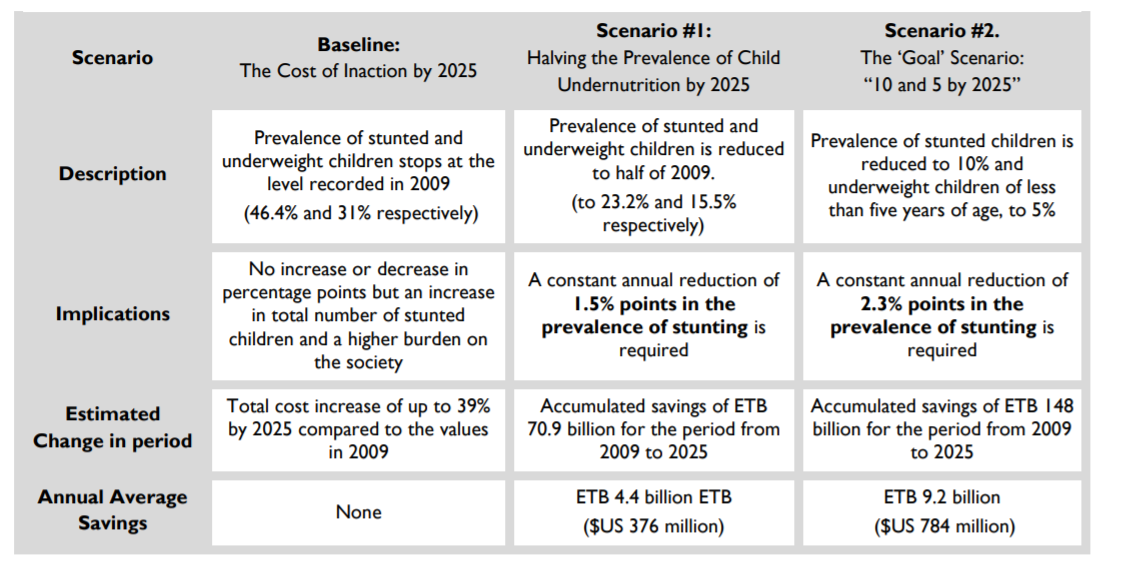
Trends in Child Stunting
Ethiopia has also made important progress in the reduction of child undernutrition in the last decade. According to the 2011 DHS survey, approximately 44.2% of Ethiopian children under-five were suffering from low height for their age (stunting), which represents an important improvement from the 50.7% reported by DHS in 2005. Additionally, the prevalence of underweight children has also improved from 34.5% to 29.2%. For that same period, low birth weight (LBW) in children has also improved from 14% (2005) to 11% (2011). In spite this positive trends, stunting still remains a critical challenge to the country as 2 out of every 5 children in Ethiopia remains stunted.
Initial Results
The Social and Economic Cost of Child Undernutrition in Ethiopia Overall results in Ethiopia show that an estimated 55.5 billion Ethiopian birr (ETB) was lost in the year 2009 as a result of child undernutrition. This is equivalent to 16.5% of GDP. For 2009, there were an estimated 4.4 million additional clinical episodes associated with undernutrition in children under five, which incurred a cost of an estimated ETB 1.8 billion. Cases of diarrhoea, fever, respiratory infections and anaemia totalled 1.3 million episodes in addition to the 3.1 million cases of underweight children. According to the estimated data, only 3 out of every 10 of all episodes received proper health attention.
Undernutrition was associated with 24% of all child mortalities which represented 379,000 in the period from 2004 to 2009. In primary education, stunted children have a higher grade repetition rate, at 15.1% than non-stunted children, at 11.2%, based on statistics for 2009. This incremental rate generated 152,000 additional cases of grade repetition in 2009, in which the education system and families incurred a cost of ETB 93 million. Stunted children in Ethiopia are also more likely to drop out of school. Based on information from the EHICES 2010/11, the model estimated that for 2009 the average schooling achievement for a person who was stunted as a child is 1.07 years lower than for a person who was never undernourished. The resulted disadvantage in the labour market is estimated to have generated private costs of ETB 625 million in potential productivity loss for that single year. 67 percent of adults in Ethiopia suffered from stunting as children. This represented more than 26.1 million people of working-age who were not able to achieve their potential, as a consequence of child undernutrition. In rural Ethiopia, where most people are engaged in manual activities, it is estimated that in 2009 alone, ETB 12.9 billion were not produced due to a lower capacity of this group. Lastly, an estimated 4.8 billion working hours were lost in 2009 due to absenteeism from the workforce as a result of nutrition-related mortalities. This represents ETB 40.1 billion, which is equivalent to 11.9% of the country‘s GDP.
Analysis of Scenarios
In addition to calculating a retrospective cost for 2009, the model can also highlight potential savings, based on three scenarios. The three scenarios are described by the chart and graph below. These scenarios are constructed based on the estimated net present value of the costs of children born in each year, from 2009 to 2025. The methodology follows each group of children and, based on each scenario, estimates a progressive path towards its achievement.

Summary of Conclusions and Recommendations
The Cost of Hunger in Africa (COHA) Study presents an opportunity to better understand the role that child nutrition can play as a catalyst for social and economic transformation, and human development. In Ethiopia the results of the study strongly suggest that, to achieve sustainable human and economic growth, special attention must be given to addressing nutrition in the early stages of an individual‘s life. The study estimates that child undernutrition generates health costs equivalent to 0.5% of the total public budget allocated to health and that only 3 out of every 10 children are estimated to be receiving proper health attention. The study further demonstrates that 28% of all cases of child mortality are associated with the higher risk of undernutrition. With regards to education, the results show that 16% of all grade repetitions in school are associated to the higher incidence of repetition experienced by stunted children. Some of the key findings of the study indicate the need for scaling-up current interventions and developing innovative solutions to fight child undernutrition in Ethiopia. Going forward, it is recommended that the Government of Ethiopia promotes access to and the utilization of nutrition sensitive health services; scales up complementary feeding practices and local food processing; explores further opportunities in bio-fortification; sets aggressive targets for the reduction of stunting; delivers nutrition services to adolescents; and addresses bottlenecks in policy and practice, that undermine the efficiency of existing nutrition interventions.
